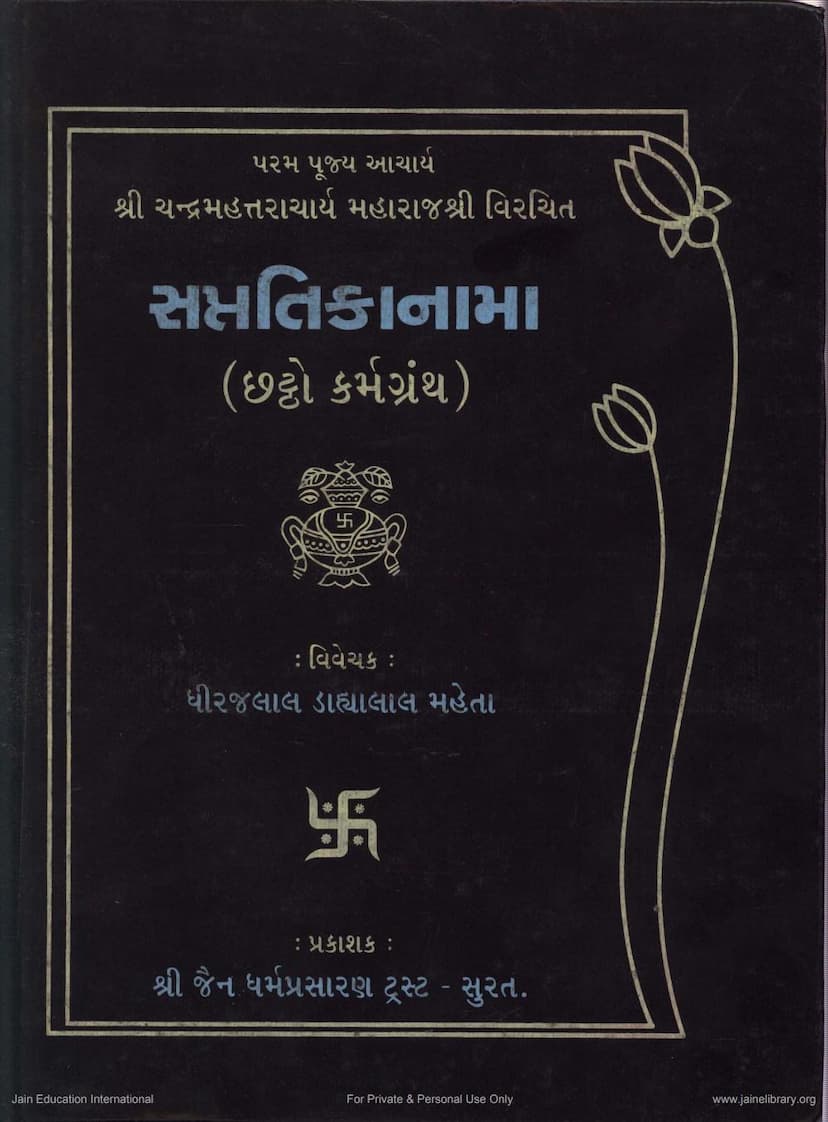Karmagrantha Part 6 Sapttika Nama
Added to library: September 2, 2025

Summary
The book "Karmagrantha Part 6: Saptatika Nama" by Chandrashi Mahattar, with commentary by Dhirajlal D. Mehta and published by Shri Jain Dharm Prasaran Trust, Surat, is the sixth in a series of six Karmagrantha books in Jain philosophy. This particular volume focuses on the "Saptatika Nama," which is believed to be the sixth Karmagrantha originally composed by Acharya Chandramhattaracharya.
The book is a detailed exposition of Jain principles related to karma, specifically elaborating on the nuances of karmic bondage, manifestation (udaya), and coexistence (satta). It delves into the complex classifications and interactions of different types of karma, providing a systematic study of how karmas affect the soul.
Here's a breakdown of the key aspects based on the provided text:
-
Author and Commentary: The original work is by Param Pujya Acharya Shri Chandramhattaracharya Maharajshri, and the commentary and simplified Gujarati explanation are by Shri Dhirajlal Dahyalaal Mehta.
-
Core Subject Matter: The book is fundamentally about karma in Jainism, explaining its various aspects like:
- Bandha (Bondage): How souls become bound by karmic particles.
- Udaya (Manifestation/Experience): How these karmas manifest and are experienced by the soul in the form of pleasures and pains.
- Satta (Coexistence): How karmas remain in a latent state with the soul until they mature for experience.
- Sthanaka (States/Categories): The different categories or stages related to bondage, manifestation, and coexistence.
- Bhanga (Modes/Variations): The numerous permutations and combinations of these karmic states, often referred to as "bhangajal" (web of modes) due to their complexity.
-
Structure and Content: The text systematically breaks down the core concepts through a series of verses (gathas). It explains:
- Karmic Classification: It likely builds upon the foundational understanding of the eight types of basic karmas (Jnanavaraniya, Darshanavaraniya, Vedaniya, Mohaniya, Ayushya, Namakarma, Gotra, Antaraya) and their numerous sub-categories (uttara prakriti). The text details the number of these sub-categories for each karma type.
- Samyog (Co-occurrence of States): The book meticulously analyzes how different karmic states (bandha, udaya, satta) interact and occur simultaneously across various stages of spiritual development.
- Gunashthanaka (Stages of Spiritual Evolution): A significant portion of the book is dedicated to explaining how karmic processes manifest differently across the fourteen stages of spiritual development in Jainism. It details the specific types and numbers of karmas bound, manifested, or in coexistence at each stage.
- Jeevashthanaka (Types of Souls/Beings): Similarly, it analyzes how karmas relate to the fourteen types of souls based on their sensory perception, consciousness, and other attributes.
- Margana (Pathways/Dispositions): The text also discusses the influence of seventy-two marganas (pathways or dispositions) on karmic processes.
- Detailed Analysis: The commentary provides detailed explanations, often referencing other Jain scriptures like Karma Prakriti, Saptatika Bhashya, and Panch Sangraha, to clarify the intricate concepts. The text highlights the profound depth and subtlety of these concepts, acknowledging their difficulty even for scholars.
-
Purpose: The book aims to provide a simplified and accessible (sukhabodha) explanation of these complex karmic principles, making the sixth Karmagrantha understandable to a wider audience. It serves as a guide to understanding the mechanics of karma, which is central to achieving liberation (moksha) in Jainism, as liberation is achieved by eradicating karma.
-
Key Takeaway: The fundamental message is that the soul is intrinsically pure and full of infinite virtues, but these are obscured by karmic coverings. To achieve the soul's pure state, one must understand, shed, and exhaust these karmas by studying their true nature. The "Saptatika Nama" is presented as a significant text in this endeavor, drawing from the rich tradition of Jain scriptural analysis.
-
Additional Information: The preliminary pages also list other published works by the same author and publisher, indicating a significant contribution to Jain literature. The publication details (Vikram Samvat, Isvi San, Veer Samvat, price, and printer) are also provided, indicating a published edition aimed at dissemination.
In essence, "Karmagrantha Part 6: Saptatika Nama" is an advanced treatise within Jain philosophy that provides a profound and systematic exploration of the intricate workings of karma, its manifestation across different spiritual and existential states, and its crucial role in the soul's journey towards ultimate purity and liberation.